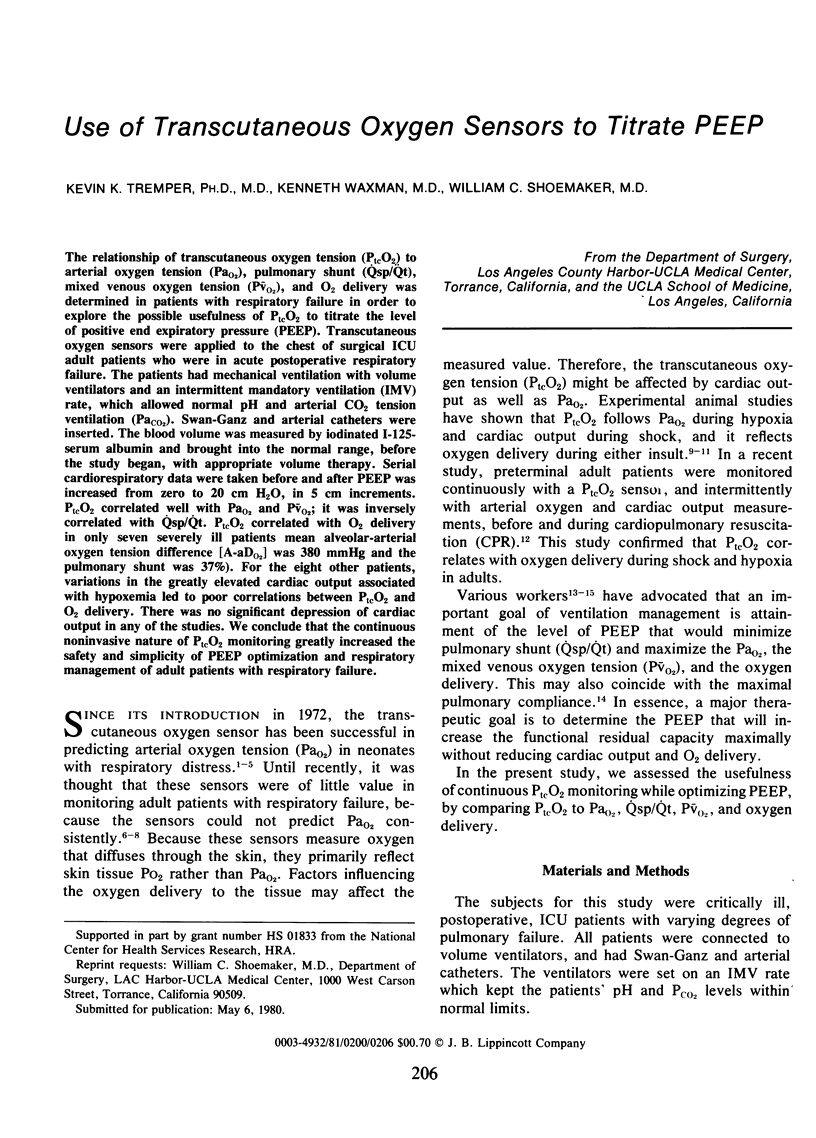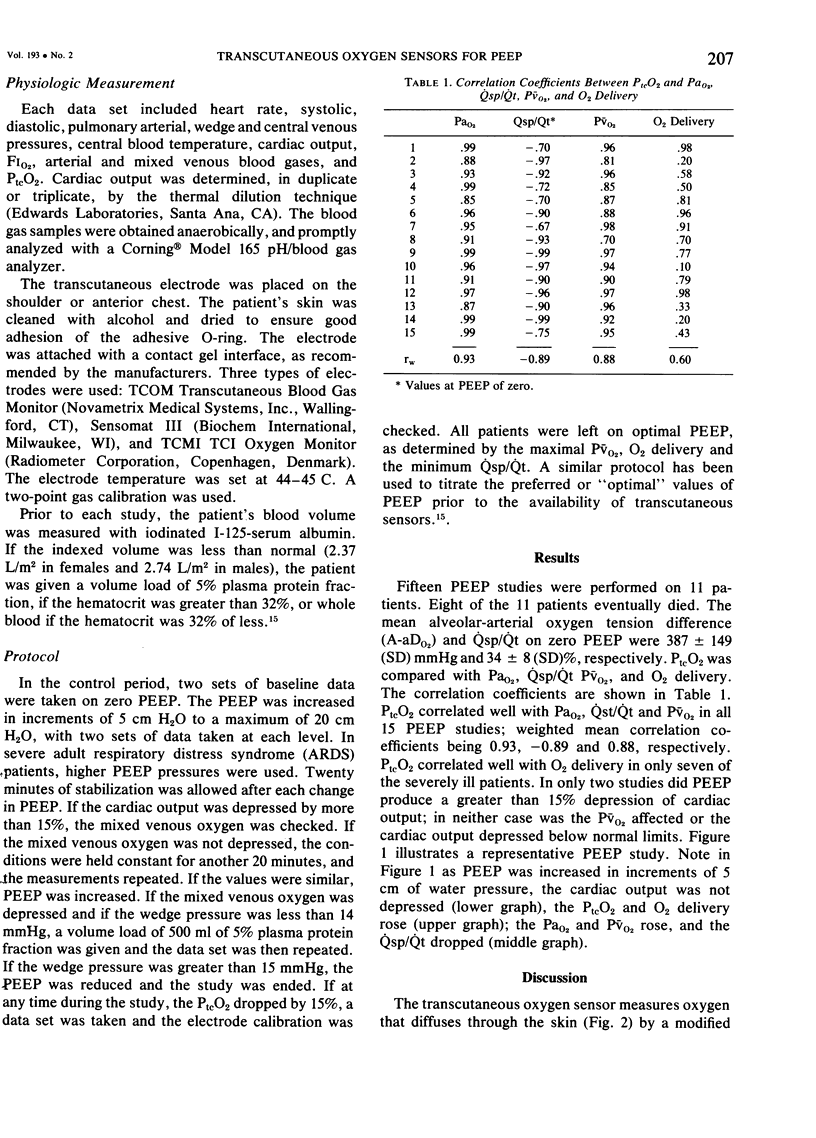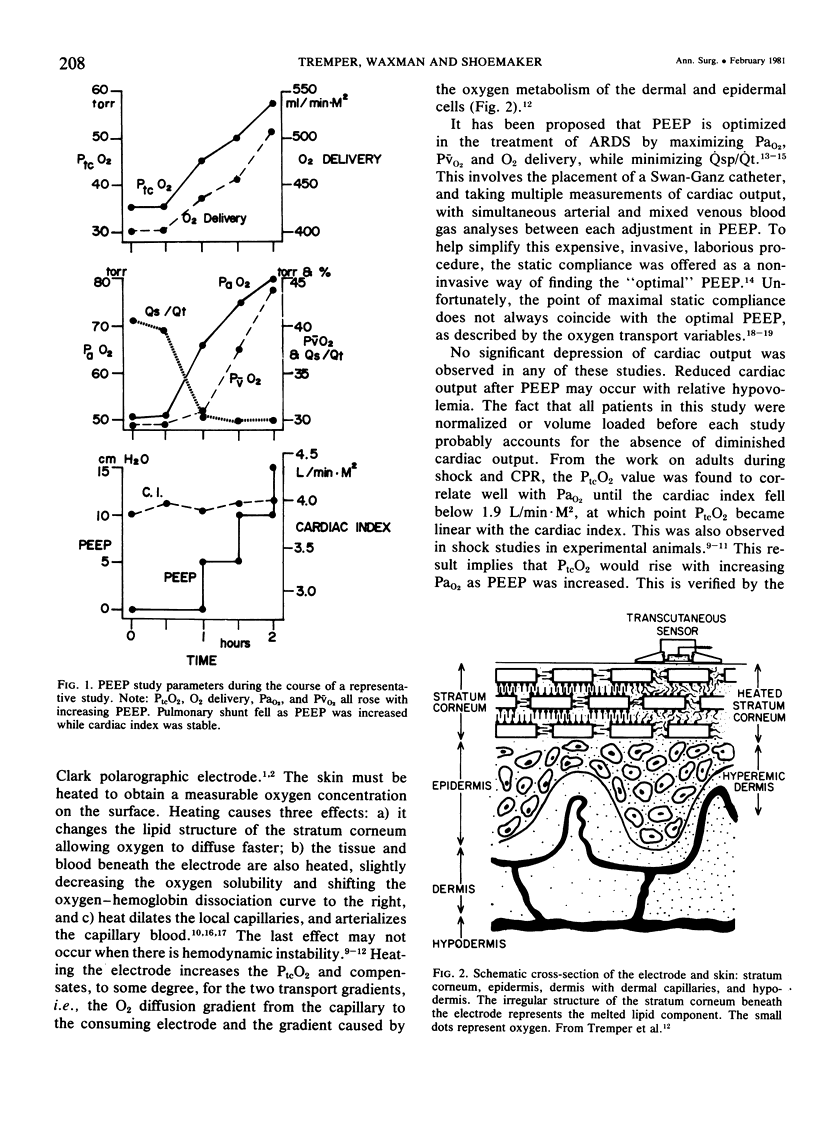Abstract
The relationship of transcutaneous oxygen tension (PtcO2) to arterial oxygen tension (PaO2), pulmonary shunt (Qsp/Qt), mixed venous oxygen tension (PVO2), and O2 delivery was determined in patients with respiratory failure in order to explore the possible usefulness of PtcO2 to titrate the level of positive end expiratory pressure (PEEP). Transcutaneous oxygen sensors were applied to the chest of surgical ICU adult patients who were in acute postoperative respiratory failure. The patients had mechanical ventilation with volume ventilators and an intermittent mandatory ventilation (IMV) rate, which allowed normal pH and arterial CO2 tension ventilation (PacO2). Swan-Ganz and arterial catheters were inserted. The blood volume was measured by iodinated I-125-serum albumin and brought into the normal range, before the study began, with appropriate volume therapy. Serial cardiorespiratory data were taken before and after PEEP was increased from zero to 20 cm H2O, in 5 cm increments. PtcO2 correlated well with PaO2 and PV-O2; it was inversely correlated with Qsp/Qt. PtcO2 correlated with O2 delivery in only seven severely ill patients mean alveolar-arterial oxygen tension difference [A-aDO2] was 380 mmHg and the pulmonary shunt was 37%). For the eight other patients, variations in the greatly elevated cardiac output associated with hypoxemia led to poor correlations between PtcO2 and O2 delivery. There was no significant depression of cardiac output in any of the studies. We conclude that the continuous noninvasive nature of PtcO2 monitoring greatly increased the safety and simplicity of PEEP optimization and respiratory management of adult patients with respiratory failure.
Full text
PDF



Selected References
These references are in PubMed. This may not be the complete list of references from this article.
- Eberhard P., Mindt W., Jann F., Hammacher K. Continuous pO2 monitoring in the neonate by skin electrodes. Med Biol Eng. 1975 May;13(3):436–442. doi: 10.1007/BF02477116. [DOI] [PubMed] [Google Scholar]
- Eberhard P., Mindt W. Skin sensors for continuous oxygen monitoring of newborns. Biotelemetry. 1977;4(2):48–76. [PubMed] [Google Scholar]
- Goeckenjan G., Strasser K. Relation of transcutaneous to arterial pO2 in hypoxaemia, normoxaemia and hyperoxaemia. Investigations in adults with normal circulation and in patients with circulatory insufficiency. Biotelemetry. 1977;4(2):77–87. [PubMed] [Google Scholar]
- Grenvik A. Optimal PEEP. Acta Anaesthesiol Scand Suppl. 1978;70:165–171. [PubMed] [Google Scholar]
- Huch R., Huch A., Albani M., Gabriel M., Schulte F. J., Wolf H., Rupprath G., Emmrich P., Stechele U., Duc G. Transcutaneous PO2 monitoring in routine management of infants and children with cardiorespiratory problems. Pediatrics. 1976 May;57(5):681–690. [PubMed] [Google Scholar]
- Kimmich H. P., Kreuzer F. Model of oxygen transport through the skin as basis for absolute transcutaneous measurement of PaO2. Acta Anaesthesiol Scand Suppl. 1978;68:16–19. doi: 10.1111/j.1399-6576.1978.tb01387.x. [DOI] [PubMed] [Google Scholar]
- Matsen F. A., 3rd, Wyss C. R., Pedegana L. R., Krugmire R. B., Jr, Simmons C. W., King R. V., Burgess E. M. Transcutaneous oxygen tension measurement in peripheral vascular disease. Surg Gynecol Obstet. 1980 Apr;150(4):525–528. [PubMed] [Google Scholar]
- Rooth G., Hedstrand U., Tydén H., Ogren C. The validity of the transcutaneous oxygen tension method in adults. Crit Care Med. 1976 May-Jun;4(3):162–165. doi: 10.1097/00003246-197605000-00009. [DOI] [PubMed] [Google Scholar]
- Rowe M. I., Weinberg G. Transcutaneous oxygen monitoring in shock and resuscitation. J Pediatr Surg. 1979 Dec;14(6):773–778. doi: 10.1016/s0022-3468(79)80263-8. [DOI] [PubMed] [Google Scholar]
- Tenaillon A., Labrousse J., Gateau O., Lissac J. Optimal positive end-expiratory pressure and static lung compliance. N Engl J Med. 1978 Oct 5;299(14):774–775. doi: 10.1056/NEJM197810052991411. [DOI] [PubMed] [Google Scholar]
- Tremper K. K., Waxman K., Bowman R., Shoemaker W. C. Continuous transcutaneous oxygen monitoring during respiratory failure, cardiac decompensation, cardiac arrest, and CPR. Transcutaneous oxygen monitoring during arrest and CPR. Crit Care Med. 1980 Jul;8(7):377–381. doi: 10.1097/00003246-198007000-00003. [DOI] [PubMed] [Google Scholar]
- Tremper K. K., Waxman K., Shoemaker W. C. Effects of hypoxia and shock on transcutaneous PO2 values in dogs. Crit Care Med. 1979 Dec;7(12):526–531. doi: 10.1097/00003246-197912000-00003. [DOI] [PubMed] [Google Scholar]
- Van Duzee B. F. Thermal analysis of human stratum corneum. J Invest Dermatol. 1975 Oct;65(4):404–408. doi: 10.1111/1523-1747.ep12607656. [DOI] [PubMed] [Google Scholar]
- Walkinshaw M., Shoemaker W. C. Use of volume loading to obtain preferred levels of PEEP. A preliminary study. Crit Care Med. 1980 Feb;8(2):81–86. doi: 10.1097/00003246-198002000-00006. [DOI] [PubMed] [Google Scholar]


